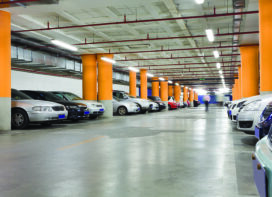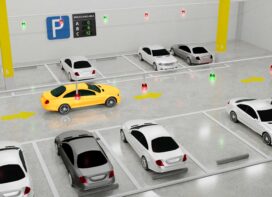
With increasing vehicular ownership and subsequent traffic volume on the roads, there is pressure on both on-street and off-street parking in India. Shrinking parking space, changing urban infrastructure & policies and innovations in design and technology are influencing parking management. Trafficinfratech spoke to experts – enforcement authorities, town planners, architects and technology providers to find out the challenges faced and probable solutions to meet parking trials head-on. Our experts include R Sudhakar, IPS – Additional Commissioner of Police, Traffic, Greater Chennai, Manish Kumar Agarwal, IPS – Additional Commissioner of Police Traffic, Indore, Amrita Chowdhury, CEO, Gaia Smart Cities, and Gian P Mathur, Managing Director, GPM Architects and Planners.
Parking violations happen on most city roads as while there are demarcated No-parking zones, specific parking zones do not exist. It is the enforcement agency that identifies these zones, though I feel the road owning agency must take the ownership based on the width of the road.
– R Sudhakar
Despite being one of the fastest growing economies in the world, India has been facing parking problems in major cities. The reasons could be various; from rapid urbanisation or lack of proper planning & policies to lack of well-integrated parking management system.
The Indian parking scenario is different from what it is in many other countries. Enumerating this, R Sudhakar, Addl CP, Traffic, Greater Chennai, states that the general housing plan has been to provide roads and houses. There is however, no provision to provide parking on streets. The Chennai Metropolitan Development Authority (CMDA) approvals for multi-storey buildings come with off-street parking but never parking that is outside the building (on-street). This has been a policy drawback. There is no provision for visitor’s parking or for shoppers outside grocery stores, or, for that matter, an auto stand or a new bus-stop. This has been leading to traffic congestion on particular stretches of roads.
“Parking issues are prevalent on district and arterial roads. Independent houses on district roads were built to accommodate two-wheelers within the property. In the present scenario with every family owning a car, house owners park their vehicles on the public road adjacent to their homes considering it their personal, authorised parking lot. This parking is not temporary but of a permanent nature. Traffic police are unable to enforce no-parking restrictions on such roads without stiff resistance from local residents,” adds Sudhakar.
Manish Kumar Agarwal, Additional Commissioner of Police, Traffic, Indore, concurs that since the design of Indore city is old, there are not many parking facilities available. The new developments taking place in the outskirts of the city like housing colonies and malls do not have issues related to parking. The roads in the city are inter-connected and in densely populated areas parking facilities are not good.

Actions taken to address existing parking woes:
A nodal agency CUMTA (Chennai Unified Metropolitan Transport Authority) has been created to interact with the traffic police, the Chennai Corporation, Highways, MTC and CMRL for better traffic management. This agency has taken up the parking management issue in Greater Chennai and post a survey, is coming up with a pilot project in Second Avenue, Anna Nagar. A study was conducted identifying the number of parking lots that could be made available without affecting the flow of traffic. Two lanes are to remain untouched for vehicle movement and the remaining lanes reserved for parking.
Sudhakar explains that an app has been developed which will be deployed as part of the pilot project using which commuters can check from home the availability of parking lots in Anna Nagar. The spot can be pre-booked for a scheduled duration. Differential rates have been proposed based on the number of hours of parking. If the parking exceeds the scheduled time, the vehicle owner will be fined and if the vehicle remains there without being collected beyond a point, it will be towed away. CUMTA will be the nodal agency who will maintain the parking lot and collect the fines with the help of the traffic police. The modalities are yet being discussed. “On successful completion of the pilot project, the same will be implemented across the city”.
In Indore, a number of fly-overs are being built so that the traffic moves outwards and vehicles coming into the city are diverted. “If we get a clear left turn and widen the roads, we should get more parking space. One multi-level parking is available which is constructed by the Indore municipal corporation”, says Manish Kumar Agarwal.

Creating additional space for parking:
In Chennai, however, even paid parking systems will not cater to more than 50% of the parking requirements of the city. The focus therefore is to encourage people traveling short distances to commute on two-wheelers as a last-mile-connectivity for shopping at grocery stores and local shops. “We want to encourage off-street parking as a business model. People who own land could lease it for parking. It will become a source of income for them and a decrease on the load on on-street parking. We are also encouraging people to come up with small multi-level parking as a business”, says Sudhakar.
So far, all parking facilities have been owned by the government. Private partnership is one of the ideas under consideration by the state government, especially for Chennai city. In Indore, the government is contemplating the use of school and college compounds for parking.
Echoing the initiatives being taken in Chennai and Indore, Amrita Chowdhury, Gaia Smart Cities adds that at the building planning and permission stages, cities need to consider the inclusion of public parking in private spaces. These public private partnerships to build public parking spaces in private buildings help create additional off-street parking for vehicles, she said.
There are 14,000 to 15,000 new vehicles registered in Indore every month and if 80% of them get on road, that makes it an addition of 10,000 -11,000 to manage. We are not able to find parking in the area for them. They park on the sides of the roads. When the flyovers get built, the volume of traffic will go down and we shall be able find adequate parking space.
– Manish Kumar Agarwal
How smart solutions can help:
India has already adopted several smart mobility initiatives such as Fastag and Multi Modal Mobility apps in some cities. “These solutions have the potential to be game changers in addressing the urban mobility challenge. Combined with better policies and planning, these can help resolve the parking challenges in Indian cities,” states Amrita.
Availability of parking at on-street and off-street locations can be managed by public entities such as the municipal corporation or private entities, she added. The dynamic parking data aggregation system can encourage public and private parking lot managers to share fixed and dynamic information with the local police. The same information can be made available via Traffic Information Systems across different channels to road users.
Disincentivise parking:
Parking is a key lever that cities can use to change user behaviour towards road usage. Effective provision of parking, information about available parking locations, and continuous monitoring of illegal parking ensures that network capacity and traffic flow is not reduced due to cars being parked. “Cities can also disincentivize parking by creating designated parking areas, different parking zones with differential pricing, and monetizing short term roadside usage by delivery, logistics or commercial vehicles. While most major cities around the world disincentivize private car traffic by increasing daily parking charges, cities in India including Delhi have very low parking charges” says Amrita.

Integrating parking into urban planning strategies
Looking ahead, Gian P Mathur, Managing Director, GPM Architects and Planners feels urban planners need to meticulously evaluate a spectrum of factors, encompassing land use patterns, population density, transportation infrastructure, and environmental implications, during the integration of parking facilities into urban landscapes. Design strategies include implementing mixed-use developments to mitigate parking requirements, advocating for alternative transportation modalities like public transit and cycling, and adopting smart parking technologies to enhance space efficiency. Additionally, strategies like multi-level parking structures, shared parking facilities, and dynamic pricing schemes accommodate growing demand and sustainable initiatives such as promoting carpooling and facilitating electric vehicle infrastructure, further mitigate parking challenges while aligning with environmental objectives, he said.
One of the deterrents has been the cost of hardware in building smart parking solutions and poor connectivity in basement lots. With the prevalence of FASTags, readers at entry and exit gates can help monitor real time availability while reducing the hardware requirements and sensor placement in communication blackspots.
– Amrita Chowdhury
Mixed-use developments to optimize parking space:
Characterised by integrating multiple functions in a space, mixed-use buildings generally combine multiple typologies, such as residential, commercial, retail, hospitality and even industrial buildings, explains Mathur. Apart from being space-efficient, mixed-use buildings are also extremely sustainable. Integrating multiple functions in a single space reduces the need for individual spaces scattered across the city, proving advantageous in curbing vehicular congestion and air pollution. They also use shared resources including energy, water requirements, waste management thereby reducing energy consumption and overall carbon footprint. Giving the example of his own project, he says that as a successful model for a multi-level car parking facility, the building was a mix of activities integrating a retail and entertainment destination with a major transportation hub by providing assorted parking facilities.
At GPM, we constantly design with the latest innovations that encourage energy consumption and sustainability. The first in the country, our project Unity One, Rohini, New Delhi, has a Solar Carport on the rooftop, connected through the ramp, and has significantly helped in the utilisation of the space. It has also reduced the structure’s solar heat intake, thereby reducing energy consumption.
– Gian P Mathur
 TrafficInfraTech Magazine Linking People Places & Progress
TrafficInfraTech Magazine Linking People Places & Progress


